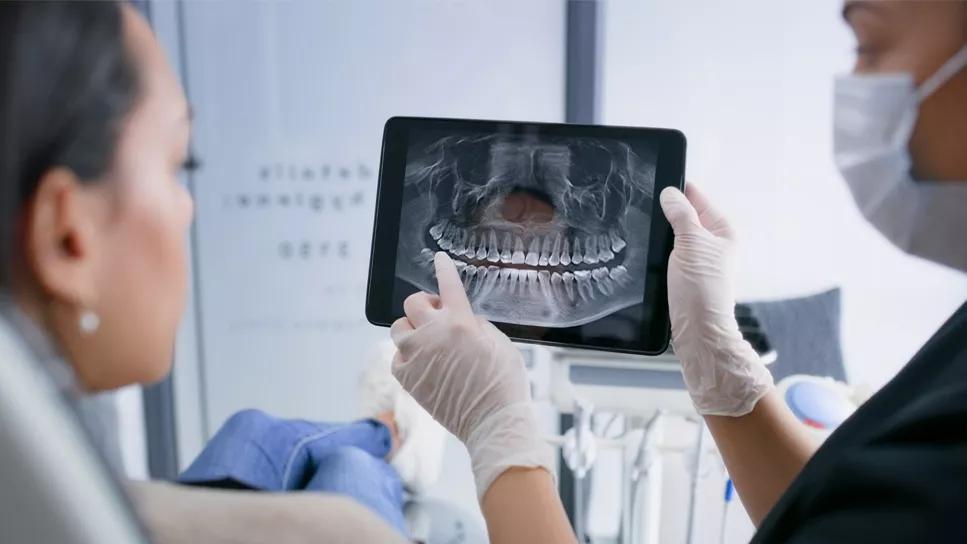New guidelines offer insight into emerging therapies, dental issues and more

In the aftermath of radiation therapy for head and neck cancer, patients can experience pain, recurrent infections and other adverse effects in and around the jawbone. How to optimally prevent and manage these outcomes is the focus of new clinical guidelines developed by Cleveland Clinic Cancer Institute radiation oncologist Shlomo Koyfman, MD, and a panel of multidisciplinary experts.
Advertisement
Cleveland Clinic is a non-profit academic medical center. Advertising on our site helps support our mission. We do not endorse non-Cleveland Clinic products or services. Policy
“With recurrent infections and pain from osteoradionecrosis (ORN), it’s hard to chew, hard to eat and there can be constant pain, interfering with the ability to talk. It can require narcotics and repeated antibiotics to manage complications,” Dr. Koyfman says.
ORN can be insidious. For example, some patients are asymptomatic. “Sometimes the bone is kind of whittling away -- you can get x-rays and see it weakening, but the patient doesn’t actually have symptoms,” says Dr. Koyfman.
Further complicating detection of ORN is the timeline involved. Sometimes it takes 5, 10 or even up to 20 years after head and neck radiation to present clinically. “Being proactive about good dental follow-up and getting x-rays is really important,” Dr. Koyfman says.
The ORN guidelines were jointly developed by the International Society of Oral Oncology-Multinational Association for Supportive Care in Cancer and the American Society of Clinical Oncology (ASCO). Dr. Koyfman is Co-Chair of the ASCO Clinical Practice Guidelines group.
Radiation therapy for head and neck cancer has become more targeted. This newer intensity modulated radiation therapy (IMRT) spares more of the surrounding tissue and structures.
Historically, a beam of radiation from each side of the face irradiated everything in its path. “The jawbone always got a very predictable high dose, so you could kind of treat everybody the same way,” Dr. Koyfman says. Now with IMRT, radiation planning is individualized, based on factors such as the area in need of irradiation and whether there is lymph node involvement.
Advertisement
As a result, ORN treatment is less standardized. Therefore, goals of the guidelines, published online May 1, 2024 in the Journal of Clinical Oncology, include greater awareness and more uniform best practices to prevent and manage ORN. A companion report in the JCO-Oncology Practice acts as a FAQ for clinicians in multiple specialties.
The guideline author team of head and neck surgeons, radiation oncologists, dentists and oral surgeons looked for high-quality evidence among published studies. Where the evidence was weaker, they relied on expert consensus. It was not always easy. “There's a lot of controversy about all three phases of the process, including pre-radiation planning and prophylaxis education; identifying and managing ORN after radiation therapy; and how to treat early and/or prevent it from getting worse,” says Dr. Koyfman. “All of those areas needed clarity.”
“Probably the most common call I get from any other medical professional are dentists saying, ‘I have a patient in my office, and their teeth are bad. They need to be pulled. How much radiation did you do? Where did you do it? Is it safe?’” says Dr. Koyfman. However, tooth extraction after radiation remains the leading cause of ORN. To prevent this, the guidelines recommend:
Advertisement
The guidelines also provide insight into medical therapies, including newer treatments such as pentoxifylline. They also weigh in on hyperbaric oxygen, which is a long and costly treatment.
To minimize ORN risk for its patients, Cleveland Clinic specialists work to spare the jawbone. “When we perform IMRT, we're very aggressive about reducing the margins,” Dr. Koyfman says. In addition, the Clinic offers new surgery involving rescue flaps, a less invasive procedure done before ORN progresses and requires excision of the full thickness of the jawbone. Dr. Michael Fritz, a co-author of the ORN guidelines, developed the procedure and provides it to qualifying patients at Cleveland Clinic.
Advertisement
Advertisement

New system brings much-needed clarity and guidance for moderate to advanced-stage disease classifications

Newly published research shows how the surgical technique is a game-changer for patients with ORN

Care paths and research initiatives aim to answer unmet clinical needs

Study shows high rate of hematologic responses, low rate of disease progression

Bispecific antibody bridging therapy deepens durability of BCMA CAR T-cell therapy without overlapping toxicities in patients with relapsed/refractory multiple myeloma

Phase 2 study brings pivotal advances in treatment efficacy and safety for the most challenging-to-treat population

Patient with quadruple refractory multiple myeloma achieves complete response with cell therapy

Distinct baseline immune profiles can predict response and resistance to different types of CAR-T cells.